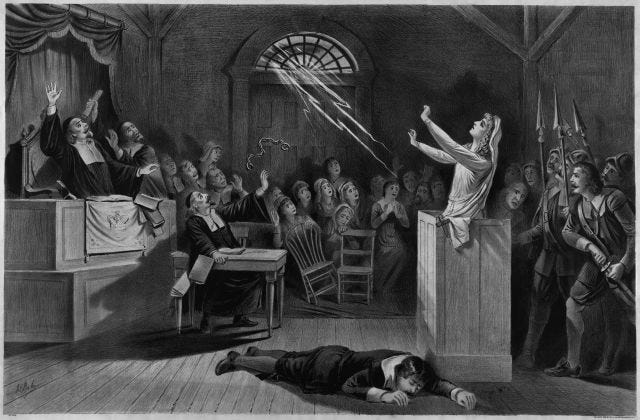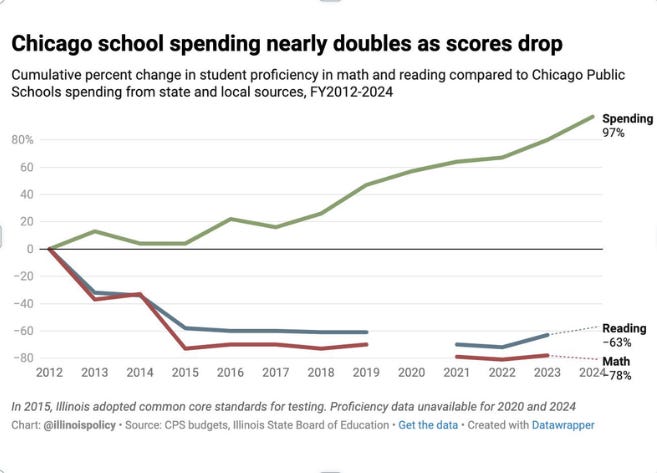#110 WITCH HUNT At The Department of Education?
We are what we always were in Salem, but now the little crazy children are jangling the keys of the kingdom, and common vengeance writes the law! -The Crucible
It’s hard to believe, but there was a time when Americans got an education without a bloated federal agency lording over them.
In 1900, the US illiteracy rate was 10.7%. By 1979, it dwindled to a flat .6%, all driven by state and local fortitude.
1979 was the year the feds conjured up the Department of Education, a bureaucratic concoction promising equality and accountability with a $14 billion price tag—courtesy of the American taxpayer.
Over the decades, the agency swelled like Mr. Stay Puft, spending $268 billion in FY 2024. Despite the cash, young people still struggle:
Picture Jermaine, 12, slouching in a Chicago Public School classroom. Although the government spends $30,000 annually per student through state, local, and federal funding, he only has a 12% chance of reading at his grade level.
Under the Florida sun, Jennifer, a sophomore in high school, dreams of becoming a marine biologist, hoping to benefit from federal STEM grants to pay for internships and Gulf dives.
Sam, 10, stumbles quietly down an Illinois dirt road. His autism relies on a slice from federal $15 billion in Individuals with Disabilities Education Act (IDEA) funding to cover the costs of his promised 1:1 aid.
Sarah, 19, sits in a college dorm making noodles on a hot plate, banking on Pell grants and financial aid to see her through.
John, 14, troubleshoots an app in a Texas charter lab, with aspirations of becoming a successful developer with the help of millions in federal tech funding designed to purchase equipment, advanced instructors, and engaging learning experiences.
That’s a lot of money. But has the cash benefited these students the way it was intended?
Last week, President Trump signed the Executive Order to dismantle the Department of Education.
But will the move come back to haunt him?
Argument: Without the DOE, American Students Will Suffer

We shouldn’t be attempting to dismantle or defund the Department of Education. We should be supporting it. It is a shared resource that benefits all schools without dictating any curriculum. The more our education system improves, the more prosperous our nation becomes. @jaredryansears on X.
Main Points
Equity and Access
National Standards and Coordination
Support for Higher Education
Historical Successes
Emergency Response and Funding Flexibility
Point #1: Equity and Access

Not supporting the DOE is racist and ableist. The agency oversees the education of kids of all backgrounds. Without Title 1 funding for low-income areas or the Individuals with Disabilities Education Act (IDEA), kids like Jermaine and Sam are left in the dust.
The $16 billion (2021) from Title 1 flowing to lower-income communities keeps many schools open.
Point #2: National Standards and Coordination
The DOE collects national data to track trends impacting Civil Rights, bullying, and overall student progress. This was the original purpose of the Department of Education in 1867, spun up by President Andrew Johnson. More on that shortly.
Point #3: Support for Higher Education
Without the DOE, people like Sarah cannot take out federal Pell Grants and financial aid. Dissolving the DOE would mean that only people with money and a high chance of ROI could go to college.
Point #4: Historical Successes
The original DOE closed in 1868 after a year of service due to concerns of government overreach, and the agency was demoted to the Office of Education.
But starting in the 1950s, political and social changes required expanded funding. With rising poverty levels and racial strife, it was time to promote the agency. Since the 1970s, minority enrollment has doubled.
Point #5: Emergency Response and Funding Flexibility
If you thought the pandemic was tough, imagine going through it with less government. In 2020, the Department of Education provided relief with the Coronavirus Aid, Relief, and Economic Security Act (CARES). State and local governments would not have come close to that kind of assistance.
Rebuttal: DOE is a Racket! Shut it Down!
Want to protect our children? Close the Department of Education and SCRAP the teachers unions. -Glenn Beck
Main Points
Decentralization and Local Control
Cost Savings
Limited Impact on Outcomes
Philosophical Opposition to Federal Involvement
Red Tape and Bureaucratic Inefficiency
Point #1: Decentralization and Local Control
The US is a large country with many people of diverse backgrounds. What’s good for California students isn’t necessarily good for Florida students. Federal employees aren’t experts in each state and district.
Let the governors and mayors do their jobs without federal speedbumps such as testing logs, Individualized Education Plans (IEPs), and demographic data collection.
Point #2: Cost Savings

The DOE spent $268 billion in FY 2024 alone, ranking at number six in overall federal spending. Eliminating this federal spending could redirect funds to natural disaster victims in California and Florida.
The tax cuts would relieve pressure on parents struggling with school supplies, home care, or general living expenses.
Point #3: Limited Impact on Outcomes
Here’s the DOE in a nutshell: Spending increases, performance decreases. We see this in national test scores and performance gaps. As far as social progress goes, landmark cases like Brown vs. Board of Education happened over two decades before the DOE existed.
Schools have been integrated for decades, and modern kids grow up in a melting pot. For the rare cases where racist practices are found, state and local districts are more than capable of handling.
The Department of Education actually undermines Civil Rights laws through political propaganda such as Critical Race Theory and gender ideology.
The government doesn’t even provide school meals for lower income kids, the Department of Agriculture handles that.
Point #4: Philosophical Opposition to Federal Involvement
The Constitution grants powers to the federal government, such as authority to tax, defend the nation, and regulate international commerce. There is no mention of running the nation’s schools.
I ran a ctrl+F on the Constitution and Bill of Rights and found zero results.
Point #5: Red Tape and Bureaucratic Inefficiency
I remember my elementary school teachers buying supplies with their own money. That was part of the pitch for teachers’ unions. But that was the 1990s, over 20 years after the DOE began its reign. As far as I can tell, the DOE hasn’t even provided basic supplies since at least the 1990s.
It’s tough enough to be a teacher as it is. The mountain of red tape and bureaucracy to go along with it isn’t making the job any easier. Canning the DOE would streamline processes and allow teachers to do their jobs.
Breaking the Spell

Predicting the next day in this wicked news cycle is impossible. But let’s take a peek into the crystal ball and see what’s in store for these kids if the DOE curse remains:
Jermaine’s 17 and never escaped the hood. Despite all the king’s horses, men, and billions of dollars, he never learned to read or write at his grade level. He’s good at converting ounces to grams, though, and he’s not dead or in prison, so he’s doing relatively well.
Jennifer is 22 and drives a forklift at the local fish cannery. Her dreams of being a marine biologist fell by the wayside. Testing logs and endless forms blocked government funding for field trips and advanced curriculum.
Sam dropped out of school at 15 and now spends his days staring at a barn owl on the farm. His small school was promised federal funding, but endless bureaucracy and compliance audits got in the way. His required 1:1 aid never stuck around. Whatever “equity” the DOE was supposed to offer didn’t reach him.
Sarah, 24, waits tables by day and shakes it by night at the windowless bar at the edge of town to battle her $37,000 (2023 average) student loan debt. Her liberal arts degree hangs on the wall, mocking her when she returns from work covered in glitter and shame. She did, however, graduate from a hotplate to a proper stove, which is nice.
John is 19 and works at Best Buy’s Geek Squad. Due to confusing bureaucracy, fraudsters took advantage and robbed him of the funds intended to boost the STEM learning he was promised by campaigning politicians.
This doesn’t sound like the fairytale future the government guaranteed when the DOE crawled out of that cauldron in ‘79. Although fictional, these stories hit far too close to home for many Americans.
Yet the spell continues to possess us as we cast our tax dollars into the potion.
These kids I made up aren’t the exception, they’re the rule—either left behind to fight for scraps or turned into zombies with an insatiable appetite for tips and low wages to feed the principal on their student loans.
The DOE might do well to help kids with emergency funds where needed, but even then vampires await in the shadows to suck the blood of the American People.
Trump wants to burn this witch at the stake, and I can’t blame him. The DOE’s report card proves it does more harm than good.
It’s time to let the states decide what’s best for them and allow quicker and more efficient processes to take over.
The future doesn’t belong to the warlocks and witches of Washington. It belongs to our kids.
If an agency doesn’t improve the thing it is responsible for improving there is no reason for the agency to exist. The Department of Education has succeeded in growing administrative overhead and costs while educational outcomes remain flat. -Elon Musk
Meme of the Week

Brand of the Week: TruPlay

TruPlay, an Austin-based Christian entertainment company founded in 2019 by Brent Dusing, creates faith-based video games and digital content for kids. With talent from Nintendo, Disney, and Xbox, TruPlay targets kids ages 5-12 with ad-free games like Stained Glass and RhymVerse. It weaves Biblical values and counters the mainstream media’s influence with a mission to build spiritual growth.
Head over to TruPlay today for more info on their ~10$/month app available on iOS and Android, and claim your free seven-day trial!
American of the Week: USMC CPL Charles Gene Abrell

Gene’s platoon was pinned down against enemy forces near Hwacheon, Korea, on June 10, 1951. Already wounded multiple times from grenades and gunfire, the Marine charged forward into the hostile machine gun emplacement while pulling a grenade pin.
Hurling himself into the enemy’s position with grenade in hand, Gene took out the entire gun team and himself. He was awarded the Congressional Medal of Honor.
Gene was from Terre Haute, Indiana, and he was only 19 years old. Remember Gene today.






